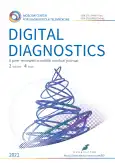Osteopoikilosis in the ribs, pelvic region and spine: a case report
- Authors: Paparella M.T.1, Gangai I.1, Porro C.1, Eusebi L.2, Silveri F.3, Cammarota A.4, Guglielmi G.1,5
-
Affiliations:
- Department of Clinical and Experimental Medicine, Foggia University School of Medicine
- Radiology Unit, Carlo Urbani
- Rheumatology Unit, University of Ancona
- IRCCS-CROB
- Radiology Unit, Barletta University Hospital
- Issue: Vol 2, No 4 (2021)
- Pages: 481-487
- Section: Case reports
- URL: https://journals.rcsi.science/DD/article/view/79504
- DOI: https://doi.org/10.17816/DD79504
- ID: 79504
Cite item
Abstract
Osteopoikilosis is a rare inherited benign bone dysplasia incidentally found on radiological exams. It is characterized by a specific radiological pattern: diffuse, round or oval, symmetrically shaped sclerotic bone areas distributed throughout the skeleton. It is essential to do a correct diagnosis because these lesions could be easily confused with bone metastasis.
We reported a case of an osteopoikilosis patient presenting to our clinic with transient loss of consciousness and without any numbness, tingling and weakness in the legs or other parts of the body. The computed tomography scan showed multiple small sclerotic foci bone islands, scattered throughout the thoracic and lumbar spine, ribs, pelvic bone, sacrum and bilateral proximal femur. No significant increase in the activity was detected in technetium-99m whole-body bone scintigraphy. The patient was diagnosed with characteristic radiological findings of osteopoikilosis and was followed up.
Keywords
Full Text
##article.viewOnOriginalSite##About the authors
Maria Teresa Paparella
Department of Clinical and Experimental Medicine, Foggia University School of Medicine
Email: mt.paparella@gmail.com
ORCID iD: 0000-0003-2573-9509
MD
Italy, Viale L. Pinto 1, 71121, FoggiaIlaria Gangai
Department of Clinical and Experimental Medicine, Foggia University School of Medicine
Email: hilary_ps@libero.it
ORCID iD: 0000-0001-9594-4810
MD
Italy, Viale L. Pinto 1, 71121, FoggiaChiara Porro
Department of Clinical and Experimental Medicine, Foggia University School of Medicine
Email: chiara.porro@unifg.it
ORCID iD: 0000-0002-7526-6968
MD
Italy, Viale L. Pinto 1, 71121, FoggiaLaura Eusebi
Radiology Unit, Carlo Urbani
Email: lauraeu@virgilio.it
ORCID iD: 0000-0002-4172-5126
MD
Italy, JesiFerdinando Silveri
Rheumatology Unit, University of Ancona
Email: fsilveri@libero.it
ORCID iD: 0000-0002-7847-245X
MD
Italy, AnconaAldo Cammarota
IRCCS-CROB
Email: aldo.cammarota@crob.it
ORCID iD: 0000-0003-4211-5140
MD
Italy, Rionero in VultureGiuseppe Guglielmi
Department of Clinical and Experimental Medicine, Foggia University School of Medicine; Radiology Unit, Barletta University Hospital
Author for correspondence.
Email: giuseppe.guglielmi@unifg.it
ORCID iD: 0000-0002-4325-8330
MD, Professor
Italy, Viale L. Pinto 1, 71121 Foggia; FoggiaReferences
- Negi RS, Manchanda KL, Sanga S, et al. Osteopoikilosis ― spotted bone disease. Med J Armed Forces India. 2013;69(2):196–198. doi: 10.1016/j.mjafi.2012.05.009
- Mahbouba J, Mondher G, Amira M, et al. Osteopoikilosis: a rare cause of bone pain. Caspian J Intern Med. 2015;6(3):177–179.
- Carpintero P, Abad JA, Serrano P, et al. Clinical features of ten cases of osteopoikilosis. Clin Rheumatol. 2004;23(6):505–508. doi: 10.1007/s10067-004-0935-2
- Tong EC, Samii M, Tchang F. Bone imagingas an aid for the diagnosis of osteopoikilosis. Clin Nucl Med. 1988;13(11):816–819. doi: 10.1097/00003072-198811000-00009
- Drouin CA, Grenon H. The association of Buschke–Ollendorf syndrome and nail-patella syndrome. J Am Acad Dermatol. 2002;46(4):621–625. doi: 10.1067/mjd.2002.120614
- Albers-Schönberg HE. Fortschr Roentgen. 1915;24(23):174.
- Hellemans J, Preobrazhenska O, Willaert A, et al. Loss-of-function mutations in LEMD3 result in osteopoikilosis, Buschke-Ollendorff syndrome and melorheostosis. Nat Genet. 2004;36(11):1213–1218. doi: 10.1038/ng1453
- Gutierrez D, Cooper KD, Mitchell AL, et al. Novel somatic mutation in LEMD3 splice site results in Buschke–Ollendorff syndrome with polyostotic melorheostosis and osteopoikilosis. Pediatr Dermatol. 2015;32(5):e219–220. doi: 10.1111/pde.12634
- Vanhoenacker EM, De Beuckeleer LH, Wan Hul W, et al. Sclerosing bone dysplasias: genetic and radioclinicalfeatures. Eur Radiol. 2000;10(9):1423–1433. doi: 10.1007/s003300000495
- Amezcua-Guerra LM, Mansilla LJ, Fernandez TS, et al. Osteopoikilosis in an ancient skeleton: more than a medical curiosity. Clin Rheumatol. 2005;24(5):502–506. doi: 10.1007/s10067-004-1072-7
- Niwayama G. Enostosis, hyperstosis, and periostitis. In: Resnick D., ed. Diagnosis of Bone and Joint Disorders. Philadelphia: WB Saunders; 1988. Р. 4084–4088.
- Dahan S, Bonafé JL, Laroche M, et al. Iconography of Buschke–Ollendorff syndrome: X-ray computed tomography and nuclear magnetic resonance of osteopoikilosis. Ann Dermatol Venereol. 1989;116(3):225–230.
- Mungovan JA, Tung GA, Lambiase RE, et al. Tc-99m MDP uptake in osteopoikilosis. Clin Nucl Med. 1994;19(1):6–8. doi: 10.1097/00003072-199401000-00002
Supplementary files













